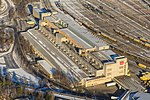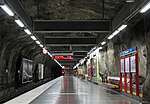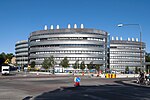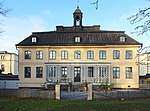Essingeleden

Essingeleden is a motorway that goes from Solna to Stockholm, Sweden, crossing the westmost parts of central Stockholm, by going over Kungsholmen, Lilla Essingen, and Stora Essingen. Essingeleden has three bridges – Fredhällsbron (270 m), Essingebron (470 m), and Gröndalsbron (460 m) – and one tunnel, Fredhällstunneln (210 m), which is one of the busiest tunnels in Europe. The road is part of European route E4 and E20, and is the busiest road in Sweden, with about 150,000 vehicles per day. In August 2007 this has increased to 170,000 cars per day, because Essingeleden was then the only road through central Stockholm exempt from the Stockholm congestion tax, and because of repairs of the main road through the inner city. This has caused big traffic jams on Essingeleden and Södra länken. Since 1 January 2016, Essingeleden has been subject to the congestion tax.
Excerpt from the Wikipedia article Essingeleden (License: CC BY-SA 3.0, Authors, Images).Essingeleden
Tomtebodakurvan, Solna kommun
Geographical coordinates (GPS) Address Nearby Places Show on map
Geographical coordinates (GPS)
| Latitude | Longitude |
|---|---|
| N 59.345 ° | E 18.011111111111 ° |
Address
Tomtebodakurvan (Essingeleden)
Tomtebodakurvan
112 17 Solna kommun, Solna Kyrkby
Sweden
Open on Google Maps











